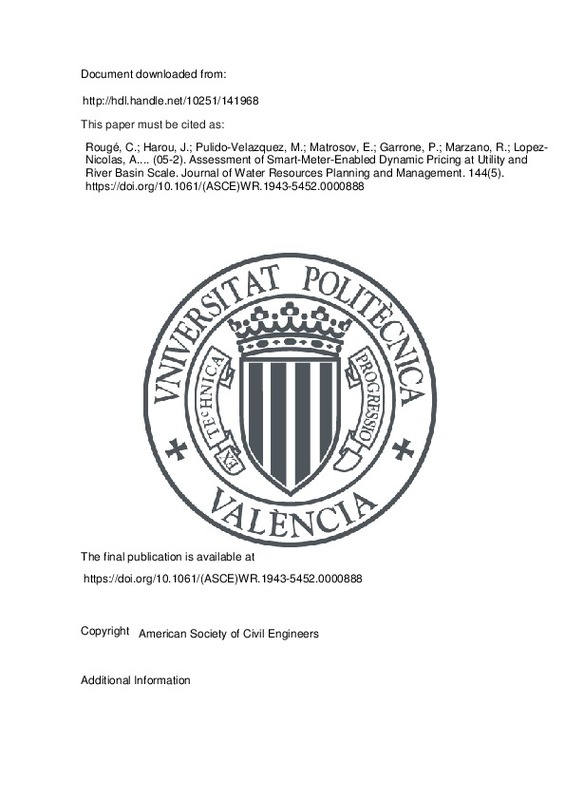Rougé, C.; Harou, J.; Pulido-Velazquez, M.; Matrosov, E.; Garrone, P.; Marzano, R.; Lopez-Nicolas, A.... (2018). Assessment of Smart-Meter-Enabled Dynamic Pricing at Utility and River Basin Scale. Journal of Water Resources Planning and Management. 144(5). https://doi.org/10.1061/(ASCE)WR.1943-5452.0000888
Por favor, use este identificador para citar o enlazar este ítem: http://hdl.handle.net/10251/141968
|
Título:
|
Assessment of Smart-Meter-Enabled Dynamic Pricing at Utility and River Basin Scale
|
|
Autor:
|
Rougé, C.
Harou, J.

 Pulido-Velazquez, M.
Matrosov, E.
Garrone, P-
Marzano, R.
Pulido-Velazquez, M.
Matrosov, E.
Garrone, P-
Marzano, R.
 Lopez-Nicolas,A.
Castelletti, A.
Rizzoli, A.
Lopez-Nicolas,A.
Castelletti, A.
Rizzoli, A.
|
|
Entidad UPV:
|
Universitat Politècnica de València. Instituto Universitario de Ingeniería del Agua y del Medio Ambiente - Institut Universitari d'Enginyeria de l'Aigua i Medi Ambient
Universitat Politècnica de València. Departamento de Ingeniería Hidráulica y Medio Ambiente - Departament d'Enginyeria Hidràulica i Medi Ambient
|
|
Fecha difusión:
|
|
|
Resumen:
|
[EN] The advent of smart metering is set to revolutionize many aspects of the relationship between water utilities and their customers, and this includes the possibility of using time-varying water prices as a demand ...[+]
[EN] The advent of smart metering is set to revolutionize many aspects of the relationship between water utilities and their customers, and this includes the possibility of using time-varying water prices as a demand management strategy. These dynamic tariffs could promote water use efficiency by reflecting the variations of water demand, availability, and delivery costs over time. This paper relates the potential benefits of dynamic water tariffs, at the utility and basin scale, to their design across a range of timescales. On one end of the spectrum, subdaily peak pricing shifts use away from peak hours to lower a utility's operational and capital expenses. On the other end, scarcity pricing factors in the variations of the marginal opportunity cost of water at weekly or longer timescales in the river basin from which water is withdrawn. Dynamic pricing schemes that act across timescales can be devised to yield both types of benefits. The analysis estimates these benefits separately for Greater London (United Kingdom) and its 15million inhabitants. Scarcity pricing implemented on a weekly timescale equates the marginal cost of residential water with estimates of the marginal economic values of environmental-recreational flows derived from tourism, property values, etc. Scarcity pricing during droughts could result in a 22-63% average reduction in environmental flow shortage while residential price increases would be capped at 150% of base levels. Yet, its ability to protect environmental flows could decrease in extreme shortage situations. The net present value of savings from peak pricing is conservatively evaluated at approximately 10million pound for each initial percentage point in daily peak-hour price increase.
[-]
|
|
Derechos de uso:
|
Reserva de todos los derechos
|
|
Fuente:
|
Journal of Water Resources Planning and Management. (issn:
0733-9496
)
|
|
DOI:
|
10.1061/(ASCE)WR.1943-5452.0000888
|
|
Editorial:
|
American Society of Civil Engineers
|
|
Versión del editor:
|
https://doi.org/10.1061/(ASCE)WR.1943-5452.0000888
|
|
Código del Proyecto:
|
info:eu-repo/grantAgreement/EC/FP7/619172/EU/SmartH2O: an ICT Platform to leverage on Social Computing for the efficient management of Water Consumption/
info:eu-repo/grantAgreement/UKRI//EP%2FG060460%2F1/GB/Water System Resilience (ARCC-Water)/
|
|
Agradecimientos:
|
The work was supported by the research project SmartH2O: an ICT Platform to leverage on Social Computing for the efficient management of Water Consumption, funded by the EU Seventh Framework Programme under Grant Agreement ...[+]
The work was supported by the research project SmartH2O: an ICT Platform to leverage on Social Computing for the efficient management of Water Consumption, funded by the EU Seventh Framework Programme under Grant Agreement No. 619172, and by EPSRC Grant No. P/G060460/1. The authors wish to thank Anna Wallen for comments on this manuscript, as well as the editor, associate editor David Rosenberg, and three anonymous reviewers, for their constructive comments.
[-]
|
|
Tipo:
|
Artículo
|







![[Cerrado]](/themes/UPV/images/candado.png)


